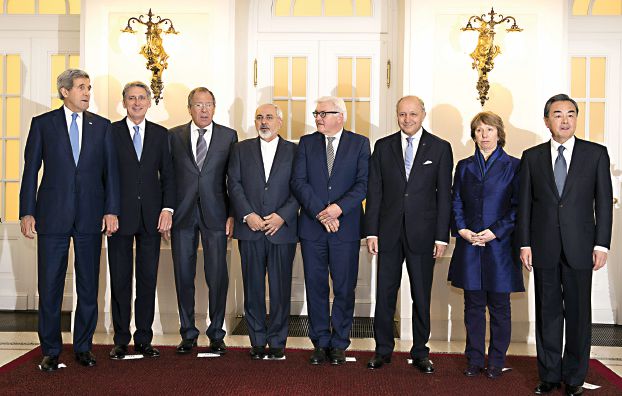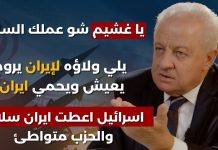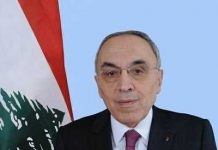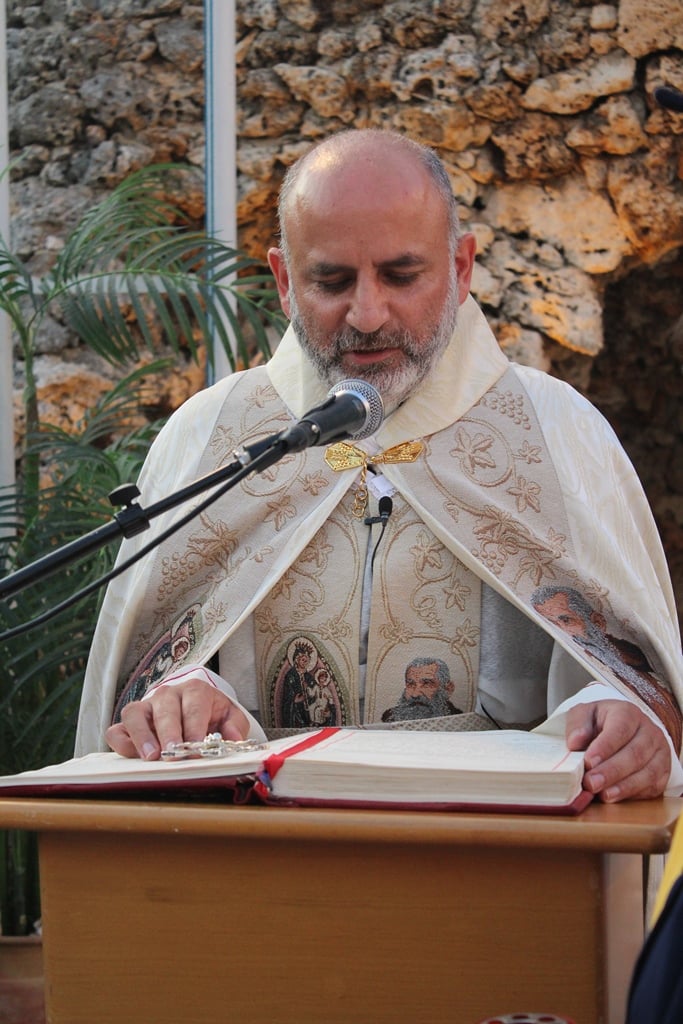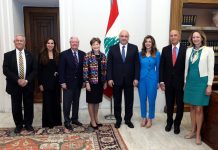Assessing the Iran Nuclear Agreement and The Washington Institute’s Iran Study Group June 24 Policy Statement/Joint Statement by Robert Satloff, Dennis Ross, James Jeffrey, Patrick Clawson, David Makovsky, Michael Eisenstadt, and Simon Henderson
Washington Institute/August 4, 2015
Since the announcement of the Joint Comprehensive Plan of Action (JCPOA), members of The Washington Institute’s Iran Study Group have met to assess the agreement’s relationship to the parameters outlined in the study group’s June 24 policy statement. Members of the study group have also benefited from several hours of discussions with senior U.S. government officials from the White House, Treasury Department, and other agencies to seek clarifications of the text and discuss areas of concern held by members of the group.
Various members of the study group have elsewhere expressed their personal views on the merits of the JCPOA; others may express such views in the coming days. The purpose of this statement is narrower than that, i.e., for The Washington Institute staff experts who are signatories of the June 24 statement to assess the relationship of the JCPOA to the Study Group’s June 24 statement. None of these staff experts have yet to express definitive judgments on the merits of the JCPOA.
The JCPOA has several major achievements, especially the long-term restrictions on key aspects of Iran’s declared nuclear program that—if fully implemented, monitored and verified—are likely to prevent Iranian nuclear breakout for up to 15 years. These include the cap on the stockpile of low-enriched uranium for 15 years, the absence of any reprocessing capabilities for this same period, the removal of the core of the Arak plutonium reactor and the monitoring of the core elements of the supply chain for 25 years.
At the same time, we assess that critical aspects of the JCPOA may fall short of the standards outlined in the study group’s June 24 statement. We recommend the following clarifications and additional measures, many of which should appropriately be addressed before Congress votes on the JCPOA.
The June 24 statement outlined five technical parameters for the agreement as well as additional points on deterrence and a “resolute regional strategy”:
Monitoring and verification. The agreement meets the study group’s parameters for access to all known sites in Iran, including 24/7 access to declared sites such as Natanz and Fordow. However, we are concerned about whether it provides adequately “timely access” when it comes to undeclared sites. The 24 days allotted to potential delaying tactics by Iran before the issue is transferred for UN Security Council action would probably not permit Iran to hide or scrub sites where nuclear material is being used in illicit fashion. But it may very well make it possible to hide other types of violations, including potential violations of Iran’s commitments in terms of weapons design work, design and manufacture of nonnuclear components used in nuclear weapons, etc. We urge the administration to clarify its plans to address these important issues to ensure the integrity of the JCPOA’s monitoring and verification provisions.
Possible military dimensions. Because the precise terms of the IAEA “roadmap” agreement with Iran on this issue are so vague, and because the agreement on access to the Parchin military site has yet to be made public, it is difficult to know whether it meets the terms specified in the study group statement: that IAEA inspectors have the ability “to take samples, to interview scientists and government officials, to inspect sites, and to review and copy documents as required for their investigation.” Further clarification is needed.
Advanced centrifuges. In the June 24 statement, the study group called for measures that “preclude the rapid technical upgrade and expansion of Iran’s enrichment capacity after the initial 10-year period.” On this issue, the agreement appears to meet our standard insofar as it stipulates a cap of 300 kilograms on the stockpile of low-enriched uranium that Iran can have for 15 years. At year 10, however, limits on centrifuges begin to be removed, and at year 15, all limits are terminated. While Iran is obligated to share with the IAEA its long-term plan for research and development on centrifuges, that plan is neither public nor binding. Without knowing the content of the plan, it is difficult to judge whether this parameter has been fully met. Given that an essential element of the JCPOA is that Iran has promised “transparency” in exchange for retaining its nuclear infrastructure, we believe it is essential that Iran’s long-term R&D plan be made public soon to allow considered judgment of whether the limitations outlined in the text reflect the intent of the JCPOA.
Sanctions relief. The JCPOA does condition the most substantial sanctions relief on Iran’s fulfillment of its core requirements, as called for in our statement. Moreover, U.S. officials have committed publicly that nonnuclear sanctions will remain fully in force. In addition, U.S. officials have also clarified for members of the study group what was not spelled out clearly in the deal:
that institutions and individuals on whom nuclear-related sanctions will be lifted can subsequently be sanctioned for terrorism or other reasons, should they merit such designations;
that b¬ecause the secondary nonnuclear sanctions remain in place, the United States will still not allow use of the U.S. dollar in trade with Iranian individuals and institutions in any way associated with Iran’s support for terrorism, meaning that Iran cannot use dollars in its oil trade; and that the United States will continue to designate for nonnuclear sanctions individuals and institutions, even those on whom nuclear sanctions are being lifted, if their conduct so merits.
These are important statements. Equally important is to make sure that other members of the P5+1, especially our European allies, understand the scope of continuing U.S. sanctions, so that tensions with our allies do not substitute for pressure on Iran. The administration should publicly clarify U.S. policy on this issue and ensure that our allies have a common understanding.
Consequences of violations. The agreement includes a creative mechanism to provide for the reimposition of UN sanctions in the event of Iranian noncompliance, as called for in the study group’s June 24 statement. But this relates to significant violations of the agreement. The snapback function may work for significant violations, but there is concern whether it will work for lesser violations and whether the United States and its partners will risk the whole agreement in order to impose penalties for lesser violations, particularly given Iran’s statement in the agreement that it reserves the right to “cease performing its commitments . . . in whole or in part” in response to reimposition of any sanctions.
From discussions with U.S. officials, we appreciate that the United States has prepared its own approach toward penalties for various types of small and mid-sized Iranian violations of the agreement, which rely principally on the reimposition of certain unilateral U.S. sanctions. However, details of this have not been made public. Moreover, lack of a common understanding on this issue within the P5+1, and even between the United States and its European allies, is a potentially serious problem. After negotiating an agreement based on the idea of collective action against the Iran nuclear threat, the resort to U.S. unilateral sanctions for penalties for Iranian violations will likely trigger U.S.-European tension precisely when the focus of collective effort should be to confront Iran with the unified stance of the JCPOA parties, even on lesser violations or infractions.
To remedy this problem, the administration needs to reach common understanding now at least with our European allies on how the JCPOA parties will respond to various types of Iranian violations. To have the most-powerful deterrent effect, the key elements of these understandings should be made public. This is important: if the United States and its allies are unable to calibrate their response to a range of possible Iranian violations now, their lack of common action later might embolden Iran to miscalculate with a major violation that could threaten the entire agreement.
A similar approach is needed toward clarifying the issue of the so-called grandfather clause in Paragraph 37 (the “snapback” paragraph). From discussions with U.S. officials, we welcome the U.S. view that this language does not shield contracts entered into legally from the impact of the reimposition of sanctions. We are, however, concerned that not all P5+1 countries share the U.S. view and are willing to confirm that publicly. The administration should seek common public clarification on this issue with all P5+1 parties as soon as possible.
In addition to these technical issues within the text, the JCPOA does not address two other essential elements of the June 24 statement:
To strengthen deterrence of Iran, it is also important for Israel to have its own independent deterrent capacity. To that end, we urge the Obama administration to commit to providing technology to Israel that would secure this objective over time, starting with proposing to transfer to Israel the Massive Ordinance Penetrator and the requisite aircraft, which will ensure that Israel has the ability at a later date to deter Iran from reaching a nuclear weapon.
A call for the United States to affirm that it is U.S. policy to use all means necessary to prevent Iran from producing sufficient fissile material (highly enriched uranium) for a nuclear weapon – or otherwise acquiring or building one – both during the agreement and after it expires. This is a vital initiative because Iran will remain a nuclear threshold state (and will clearly have retained the option of becoming a nuclear weapon state) as restrictions on stockpiles of uranium and centrifuge production lapse gradually after 10 years and, along with the ban on reprocessing, end after 15 years, and the question is raised about what would deter Iran from then developing a nuclear weapon. One powerful element of deterrence would be for the United States to go on record now that it is committed to using all means necessary, including military force, to prevent this. While some senior administration officials have made positive statements in this direction, such as the statement made in recent Congressional testimony by energy Secretary Moniz to the effect that development of HEU by Iran at any point in the future would be a red line that the United States should not allow, we urge the president now to formalize this as a declaration of a U.S. policy and Congress should formally endorse it.
To strengthen deterrence of Iran, it is also important for Israel to have its own independent deterrent capacity. To that end, we urge the Obama administration to commit to providing technology to Israel that would secure this objective over time, starting with proposing to transfer to Israel the Massive Ordinance Penetrator and the requisite aircraft, which will ensure that Israel has the ability at a later date to deter Iran from reaching a nuclear weapon.
Separate from the agreement, the study group called on the president to articulate a “resolute regional strategy” to counter Iranian negative behavior throughout the Middle East. We believe the articulation and implementation of this enhanced effort to counter Iranian negative behavior—and to support allies and partners—in the region is both important and urgent, given the substantial financial benefits Iran will receive early in the implementation of this agreement and the likelihood that considerable sums will be directed toward Iran’s destabilizing regional activities. Working with our allies, we urge the administration to build on the president’s GCC Summit and discussions of Secretaries Carter and Kerry and adopt a number of tangible steps as soon as possible.
The study group offered several specific suggestions:
In Iraq. Expand training and arming of not only Iraqi Security Forces but also Kurdish Peshmerga in the north and vetted Sunni forces in the West. Allow U.S. Special Forces to leave their bases and help coordinate air strikes and stiffen Iraqi units. Provide advisors to select brigade headquarters. Sideline Iranian-backed militia and separate them from Shiite units (“popular mobilization units”) that are not under Iranian control.
In Syria. Expand and accelerate the U.S. train-and-equip programs, even if it entails accepting certain risks in the vetting of trainees. Work with Turkey to create a safe haven in northern Syria where refugees can obtain humanitarian aid and vetted nonextremist opposition fighters can be trained and equipped. Capitalize on Bashar al-Assad’s increasing weakness to split off regime elements and seek to join them with U.S.-trained opposition elements. Interdict the transshipment of Iranian weapons into Syria in coordination with the Kurds and Turkey, and consider designating as terrorist organizations additional Iranian-backed Shiite militias responsible for atrocities
In Yemen. Expand support for Saudi Arabia and the UAE in pressuring the warring parties to the negotiating table while seeking to split the Houthi elements away from Iran.
Regionally. Interdict Iranian arms bound for extremist groups and continue to counter its Iran’s efforts to harass commercial shipping and our naval forces. Reaffirm U.S. policy on Iran’s efforts to subvert local governments and project its power at the expense of our friends and allies.
In the June 24 report, the study group noted that, taken collectively, these steps also strengthen U.S. capability against Daesh (the misnamed “Islamic State”). Acting against both Iranian hegemony and Daesh’s caliphate will help reassure friends and allies of America’s continued commitment. And it will help address Israel’s legitimate concerns that a nuclear agreement will validate Iran’s nuclear program, facilitate its destabilizing behavior, and encourage further proliferation at a time when Israel faces the possible erosion of its “qualitative military edge.” We urged the U.S. administration to create a discreet, high-level mechanism with the Israeli government to identify and implement responses to each of these concerns and understand the administration has been attempting to launch such a discussion.
While the president and top officials have made some important statements in this realm, such a “resolute regional strategy” has not been clearly and definitively articulated. Given that Iran has publicly stated its intention to pursue its negative regional behavior in the period ahead, it is important for the administration to intensify its current efforts to work closely with our allies, both in the region and more broadly, so Iran sees clearly the costs of more aggressive action.
It is important to note the connection between Iran’s regional policies and the nuclear accord. If Iran views the regional environment as permissive, in which there is not sufficient pushback against its negative regional behavior, it will be more inclined to test the bounds of the nuclear agreement. By contrast, if Iran finds that it encounters effective U.S. pushback wherever it seeks to expand its influence, it will likely be less inclined to test the limits of the nuclear agreement.
Patrick Clawson, Morningstar Senior Fellow, director of research, The Washington Institute
Michael Eisenstadt, Kahn Fellow, director of the Military and Security Studies Program, The Washington Institute
Simon Henderson, Baker Fellow, director of the Gulf and Energy Policy Program, The Washington Institute
James Jeffrey, U.S. ambassador to Iraq, 2010-2012, deputy national security advisor to President George W Bush, 2007-2008. Philip Solondz Distinguished Fellow, The Washington Institute
David Makovsky, senior policy advisor to the U.S. special envoy for Israeli-Palestinian negotiations (2013-2014). Ziegler Distinguished Fellow and director of the Project on the Middle East Peace Process, The Washington Institute
Dennis Ross, special assistant to President Obama and National Security Council senior director for the central region, 2009-2011. Counselor and William Davidson Distinguished Fellow, The Washington Institute
Robert Satloff, Howard P. Berkowitz Chair in U.S. Middle East Policy and executive director, The Washington Institute
This statement reflects the collective views of its signatories. It does not necessarily reflect the views of The Washington Institute’s Board of Directors, Board of Trustees or Board of Advisors; nor does it necessarily reflect the views of other members of the Iran Study Group.














